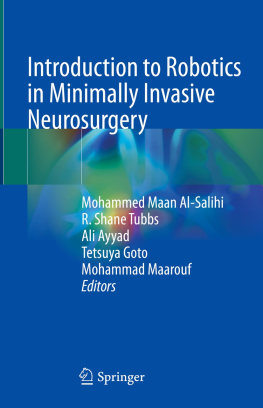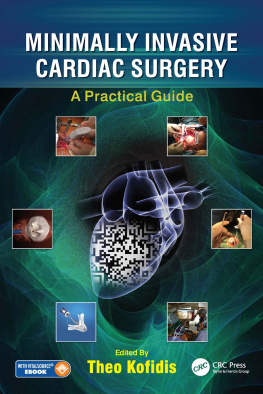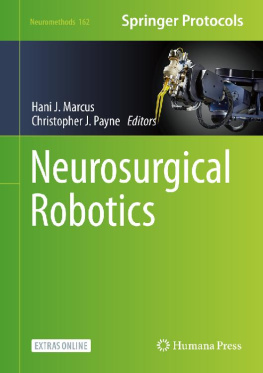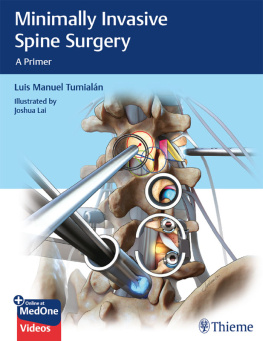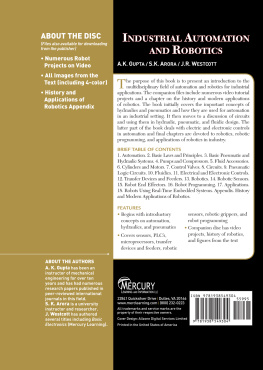Mohammad Maarouf - Introduction to robotics in minimally invasive neurosurgery
Here you can read online Mohammad Maarouf - Introduction to robotics in minimally invasive neurosurgery full text of the book (entire story) in english for free. Download pdf and epub, get meaning, cover and reviews about this ebook. City: Cham, Switzerland, year: 2022, publisher: Springer, genre: Romance novel. Description of the work, (preface) as well as reviews are available. Best literature library LitArk.com created for fans of good reading and offers a wide selection of genres:
Romance novel
Science fiction
Adventure
Detective
Science
History
Home and family
Prose
Art
Politics
Computer
Non-fiction
Religion
Business
Children
Humor
Choose a favorite category and find really read worthwhile books. Enjoy immersion in the world of imagination, feel the emotions of the characters or learn something new for yourself, make an fascinating discovery.
- Book:Introduction to robotics in minimally invasive neurosurgery
- Author:
- Publisher:Springer
- Genre:
- Year:2022
- City:Cham, Switzerland
- Rating:3 / 5
- Favourites:Add to favourites
- Your mark:
- 60
- 1
- 2
- 3
- 4
- 5
Introduction to robotics in minimally invasive neurosurgery: summary, description and annotation
We offer to read an annotation, description, summary or preface (depends on what the author of the book "Introduction to robotics in minimally invasive neurosurgery" wrote himself). If you haven't found the necessary information about the book — write in the comments, we will try to find it.
Introduction to robotics in minimally invasive neurosurgery — read online for free the complete book (whole text) full work
Below is the text of the book, divided by pages. System saving the place of the last page read, allows you to conveniently read the book "Introduction to robotics in minimally invasive neurosurgery" online for free, without having to search again every time where you left off. Put a bookmark, and you can go to the page where you finished reading at any time.
Font size:
Interval:
Bookmark:
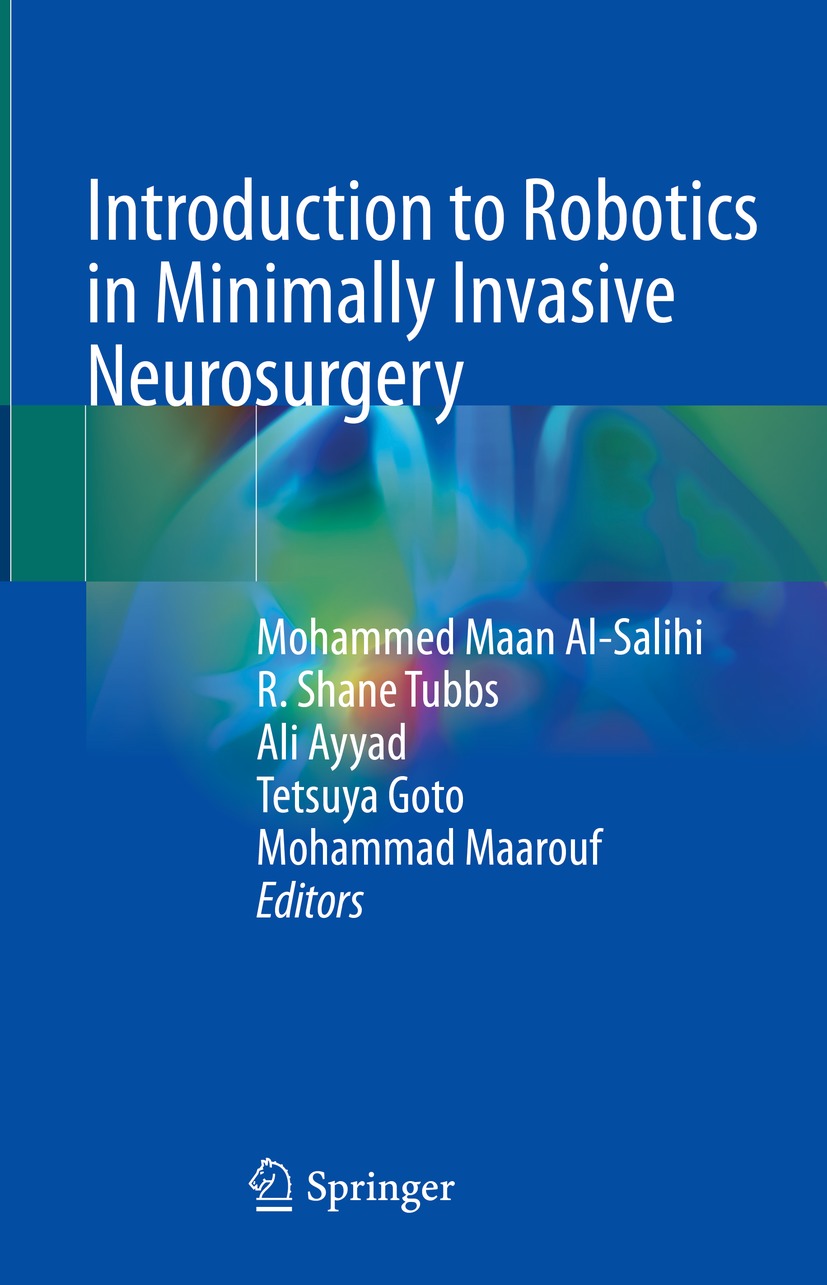

This Springer imprint is published by the registered company Springer Nature Switzerland AG
The registered company address is: Gewerbestrasse 11, 6330 Cham, Switzerland
In loving memory of Mr. Sabah, a true human being. May his soul rest in peace.
Mohammed Maan Al-Salihi
I would like to dedicate this book to my grandmother, Willodean Tubbs, who imparted wisdom and confidence in me since I was a young child.
R. Shane Tubbs
I dedicate this book to the departed soul of my father. Like the North Star, he had been my guide and his absence will always be deeply felt.
I also dedicate this book to the memory of my mentor late Professor Axel Perneczky whose teachings will always remain an immense part of my personal and professional life.
Ali Ayyad
To my mentors, Professor Shigeaki Kobayashi, Professor Kazuhiro Hongo, and Professor Yuichiro Tanaka at Shinshu University and St. Marianna University, I owe a great and long-standing debt of gratitude.
Tetsuya Goto
This book is dedicated to my beloved parents, brothers, and sisters.
And to my wife Yaman and my children Abdulrahman and Sarrah Hanan in acknowledgment of their understanding and support.
Mohammad Maarouf
Pioneers in surgerylike early explorers who sought goals like the North Pole, the South Pole, the top of Mt. Everestare sometimes ill-fated. The inventor of one of the first surgical robotsROBODOC for precision CT-guided femur reaming in hip replacementis an example. Howard A. Paul, a forward-looking veterinarian at the University of California, Davis (California, USA)who was affectionately called by his initials HAPsadly succumbed to leukemia in 1993 at the age of 44. I was fortunate in the 1990s to visit the manufacturing facilities for ROBODOC (and NeuroMate) in Lyon (France), and also to participate in another building block of neurosurgical robotics: the innovative program for image-guided surgery at Vanderbilt University. Fortunately, Hap Paul lives on in the annual Hap Paul Award of the International Society for Technology in Arthroplasty.
The editors of Introduction to Robotics in Minimally Invasive Neurosurgery are pioneers in their own rightparticularly the lead editor, Mohammed Maan Al-Salihi. To assemble such an informative book on cutting-edge neurosurgery while working in one of the worlds political hot spots requires dedication and insight far above the norm.
It comprehensively reviews the field from both the anatomical aspect (vascular, spine) and the technological aspect (stereotactic, endoscopic).
It covers the timeline from its beginnings in the 1980s (and groundwork laid decades earlier) to the future of neurosurgical robotics (artificial intelligence (AI), internet of things (IoT), brain-to-brain interface (BTBI)).
Each chapter can be read stand-alone. Although this results in some overlap and repetition, the reader can quickly access the specific information desired.
The documentation is exemplary. Most chapters have dozens of references, up-to-date and relevant; one chapter has 147 references!
Minimally invasive access to the nervous system will undoubtedly progress. As Rodolfo Llinas (Emeritus Chair of Neurophysiology at New York University) envisaged in 2005, one can drive the endovascular pathways not only along the superhighways of the internal carotid and other large arteries for coiling and stenting but also along the alleyways of the capillaries that reach every nook and cranny of the nervous system. He showed one can record and stimulate the nervous system utilizing electrodes within the blood vessels. And, as suggested by Kendall Lee at the Mayo Clinic, one can poke a micron-size catheter through the capillary wall to investigate (and manipulate!) the brain parenchymared blood cells are ten times the diameter of the penetrating catheter and thus will not leak out.
Neuroprostheses will evolve to replace parts for nervous systems defects. Researchers in Italy, the Netherlands, and the USA have developed a prototype bioinspired artificial synapse. Being able to replace defective neurons, nerve fibers, and synapseseither with artificial prostheses or stem-cell derived replacementswill revolutionize the treatment of nervous system disorders.
The brain-cloud interface (B/CI) and brain-to-brain interface (BTBI) will take neurosurgical robotics into the realm of neurosurgical crowdsourcing. A group at the University of Washington in Seattle, WA, USA, has shown that one person being monitored by EEG canthrough the internet and transcranial magnetic stimulationremotely control the motor function of another person. In essence, the second person becomes a slave of the first.
Font size:
Interval:
Bookmark:
Similar books «Introduction to robotics in minimally invasive neurosurgery»
Look at similar books to Introduction to robotics in minimally invasive neurosurgery. We have selected literature similar in name and meaning in the hope of providing readers with more options to find new, interesting, not yet read works.
Discussion, reviews of the book Introduction to robotics in minimally invasive neurosurgery and just readers' own opinions. Leave your comments, write what you think about the work, its meaning or the main characters. Specify what exactly you liked and what you didn't like, and why you think so.

